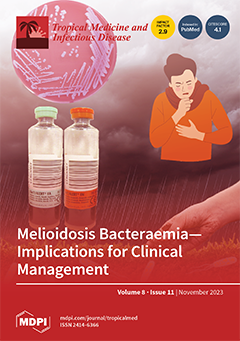In 2013, an epidemic of falciparum malaria involving over 820 persons unexpectedly broke out in Shanglin County, Guangxi Zhuang Autonomous Region, China, after a large number of migrant workers returned from Ghana, where they worked as gold miners. Herein, we selected 146 isolates
[...] Read more.
In 2013, an epidemic of falciparum malaria involving over 820 persons unexpectedly broke out in Shanglin County, Guangxi Zhuang Autonomous Region, China, after a large number of migrant workers returned from Ghana, where they worked as gold miners. Herein, we selected 146 isolates randomly collected from these patients to investigate the resistance characteristics of the parasite to sulfadoxine–pyrimethamine (SP) by screening mutations in the
dhfr and
dhps genes. All 146 isolates were successfully genotyped for
dhps, and only 137 samples were successfully genotyped for
dhfr. In the
dhfr gene, point mutations occurred at three codons: 51 (83.2%, 114/137), 59 (94.9%, 130/137), and 108 (96.4%, 132/137). In the
dhps gene, mutations occurred at four codons: 436 (36.3%, 53/146 for S436A, 0.7%, 1/146 for S436Y), 437 (95.2%, 139/146), 540 (3.4%, 5/146), and 613 (2.7%, 4/146). All 146 isolates had mutations in at least one codon, either within
dhfr or
dhps. Quadruple mutation I
51R
59N
108/G
437 (41.1%, 60/146) of partial or low resistance level was the most prevalent haplotype combination. Quintuple I
51R
59N
108/G
437E
540 accounted for 2.1% (3/146). Sextuple I
51R
59N
108/A
436G
437S
613 was also found and accounted for 1.4% (2/146). A chronological assay incorporating two sets of resistance data from the studies of Duah and Amenga-Etego provided an overview of the resistance trend from 2003 to 2018. During this period, the results we obtained generally coincided with the total development tendency of SP resistance. It can be concluded that
Plasmodium falciparum samples collected from Chinese migrant workers from Ghana presented prevalent but relatively partial or low resistance to SP. A chronological assay incorporating two sets of data around 2013 indicates that our results possibly reflect the SP resistance level of Ghana in 2013 and that the possibility of increased resistance exists. Therefore, reasonable drug use and management should be strengthened while also maintaining a continuous screening of resistance to SP. These findings also underscore the need to strengthen the prevention of malaria importation from overseas and focus on preventing its reintroduction and transmission in China.
Full article






